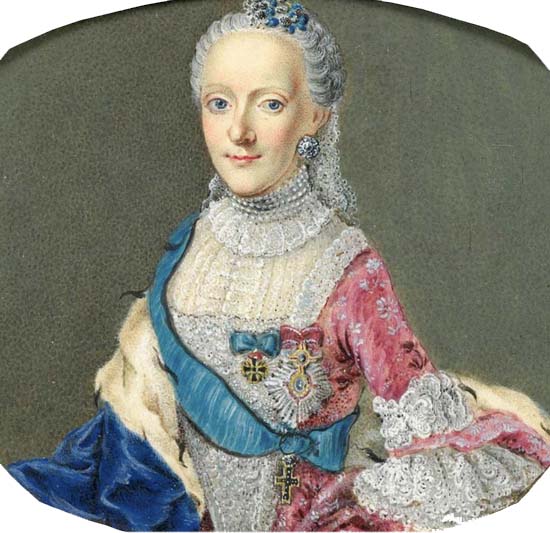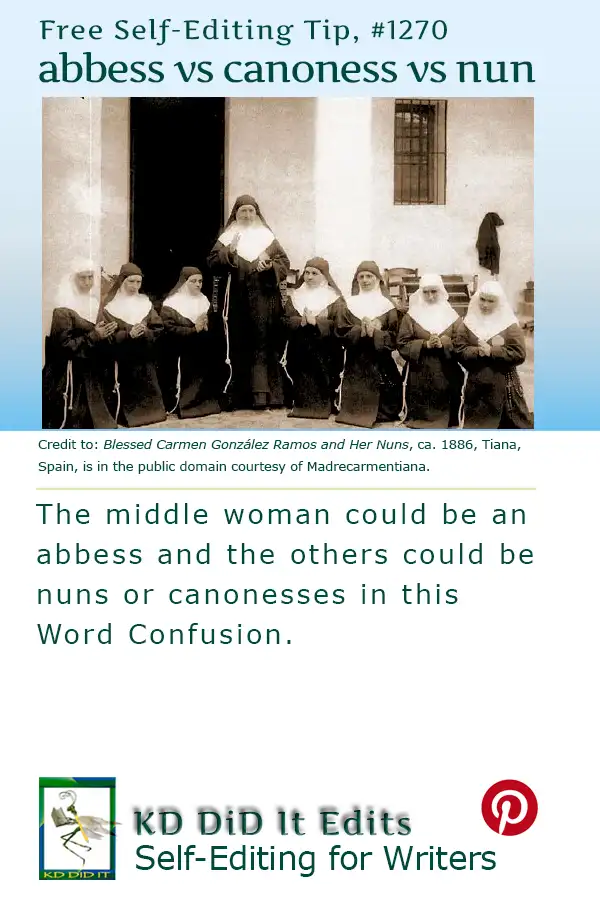This isn’t a word confusion I’ve come across, in a story, but more a matter of running across it while researching “Hermit versus Monk“.
An abbess is the female equivalent of an abbot and rules with an absolute power over a group of nuns.
A canoness is a member of a religious community who follows ecclesiastical rules but has not given up her property nor made vows.
A nun is a member of a religious community who has vowed poverty, chastity and obedience.
Several side notes that I found interesting was Nun, as a proper noun, who is the oldest of the ancient Egyptian gods (father of Ra, the sun god), personifying the primordial ocean from which the world was formed.
The second was the difference between nuns and sisters. Nuns spend their lives in prayer and working within their convent while “sisters are more active in the world, engaging in many different kinds of work, most often for people who are in great need” (Sosters).
NOTE: This post ignores nuns as a type of pigeon.
Exploring Later . . .
You may want to explore “Hermit versus Monk” and/or “Cannon versus Canon“.
Word Confusions . . .
. . . started as my way of dealing with a professional frustration with properly spelled words that were out of context in manuscripts I was editing as well as books I was reviewing. It evolved into a sharing of information with y’all. I’m hoping you’ll share with us words that have been a bête noire for you from either end.
If you found this post on “Abbess vs Canoness vs Nun” interesting, consider subscribing to KD Did It, if you’d like to track this post for future updates.
| Abbess | Canoness | Nun |
|---|---|---|
 |
 |
 |
| Part of Grammar: | ||
| Noun 1, 2
Plural: abbesses The male equivalent is an abbott. |
Noun
Plural: canonesses |
Noun
Plural: nuns |
| A woman who is the head of an abbey, a type of monastery, of nuns 1
[British slang; archaic] A woman who was the madam of a brothel 2 |
[In the Roman Catholic Church] A member of certain religious orders of women living communally and simply according to an ecclesiastical rule in the same way as nuns
|
A woman member of a religious order, especially one bound by vows of poverty, chastity, and obedience |
| Examples: | ||
| She’s the abbess of the Abbey, the Mother Superior to twenty-three nuns.
“Heloise, abbess of the Paraclete, died; celebrated as the mistress of Abelard, and for her learning” (Munsell). “Bishop Fox in his injunctions in 1507 forbade sundry priests to hold any communication with the abbess or with any of the nuns” (Perkins). “A true mother in God the abbess proved, and a dutiful and loving daughter was Æthelflæd” (Perkins,). “The Times in 1786 and 1788 exposed some of the ‘Mother Abbesses’ who ran these exclusive establishments, such as the Little Harpy of Iniquity from Germyn-street who went with her meretricious attendants to the theatre and the pleasure gardens” (L’abbess). |
“The sisters were called canonesses, and Iduberga appointed her daughter abbess” (Baring-Gould).
“The ball being ended, we went to hear vespers at the church of the Canonesses, an order of nuns of which we have none in France” (De Valois). “As to your lovers, noble canonesses, it depends upon you alone whether you will keep them or not” (Sue). “Fourteen houses were inhabited by Austin nuns or canonesses (including Sion), and two by nuns of the order of Prmontr” (Eckenstein). |
Nuns were notorious for being hard disciplinarians in Catholic schools.
“The nearby monastery has a list of rules by which the nuns live, including a dedication to silence and prayer” (Elliott). “She fills the abbey’s coffers by managing its land more intelligently, ensuring that neither her nuns nor the inhabitants of the abbey’s satellite communities go hungry” (Zacharek). |
| Derivatives: | ||
| Adjective: nunlike, nunnish Noun: nunhood, nunnery |
||
| History of the Word: | ||
|
It was first used in the 8th century of communities of women who lived in common but did not renounce their property. They were later known as secular canonesses and are now extinct.
After the 11th century many orders of canons regular had counterparts for women, whose members were known as canonesses regular. The term was first recorded in 1675–85 as canon + -ess. |
Old English nonne, from the ecclesiastical Latin nonna, feminine of nonnus meaning monk, and reinforced by the Old French nonne. |
C’mon, get it out of your system, bitch, whine, moan . . . which words are your pet peeves? Also, please note that I try to be as accurate as I can, but mistakes happen or I miss something. Email me if you find errors, so I can fix them . . . and we’ll all benefit!
Satisfy your curiosity about other Word Confusions on its homepage or more generally explore the index of self-editing posts. You may also want to explore Book Layout & Formatting Ideas, Formatting Tips, Grammar Explanations, Linguistics, Publishing Tips, the Properly Punctuated, Writing Ideas and Resources, and Working Your Website.
Resources for Abbess vs Canoness vs Nun
Some of these links may be affiliate links, and I will earn a small percentage, if you should buy it. It does not affect the price you pay.
Apple Dictionary.com
Baring-Gould, Sabine. The Lives of the Saints, vol 3. John Hodges, 1872–1877. Project Gutenberg, 2015. <https://www.gutenberg.org/files/48395/48395-h/48395-h.htm>. Ebook.
De Valois, Marguerite. The Memoirs Of Marguerite De Valois. Originally published 1800. Project Gutenberg, updated 2016. <https://www.gutenberg.org/files/3841/3841-h/3841-h.htm>. Ebook.
Dictionary.com: abbess, canoness, nun
Eckenstein, Lina. Woman under Monasticism. Originally published 1896. Project Gutenberg, 2013. <https://www.gutenberg.org/files/42708/42708-h/42708-h.htm>.Ebook.
Elliott, Christopher. “Nontraditional Lodging Fills a Need for Pandemic Travelers.” The Washington Post. 1 Sept 2021. Accessed 4 Apr 2024. <https://www.washingtonpost.com/lifestyle/travel/nontraditional-new-vacation-lodging-options/2021/09/01/415cf732-0761-11ec-a266-7c7fe02fa374_story.html>.
“L’abbess des marchands de bonheur.” Rowan and Rowan. n.d. Accessed 4 Apr 2024. <https://www.rowanandrowan.com/the-abbess/>.
Merriam-Webster: canoness
Munsell, Joel. The Every Day Book of History and Chronology. Originally published 1843. Project Gutenberg, updated 28 June 2023. <https://www.gutenberg.org/files/44028/44028-h/44028-h.htm>. Ebook.
Oxford Reference: canoness
Perkins, Thomas. Bell’s Cathedrals: A Short Account of Romsey Abbey. Originally published 1851. Project Gutenberg, 2007. <https://www.gutenberg.org/files/22880/22880-h/22880-h.htm>. Ebook.
Sue, Eugène. The Iron Pincers. Originally published 1909. Project Gutenberg, 2010. <https://www.gutenberg.org/files/33114/33114-h/33114-h.htm>. Ebook.
“What’s the Difference Between a Sister and a Nun?” Sisters of Mercy.org. n.d. Accessed 4 Apr 2024. <https://www.sistersofmercy.org/faq/whats-the-difference-between-a-sister-and-a-nun/>.
Zacharek, Stephanie. “Why Nun Stories are About to Become Your Next Pop-Culture Obsession.” Time. 2 Sept 2021. Accessed 4 Apr 2024. <https://time.com/6093678/nun-stories-matrix-lauren-groff/>.
Pinterest Photo Credits
Blessed Carmen González Ramos and Her Nuns, ca. 1886, Tiana, Spain, is in the public domain courtesy of Madrecarmentiana.


